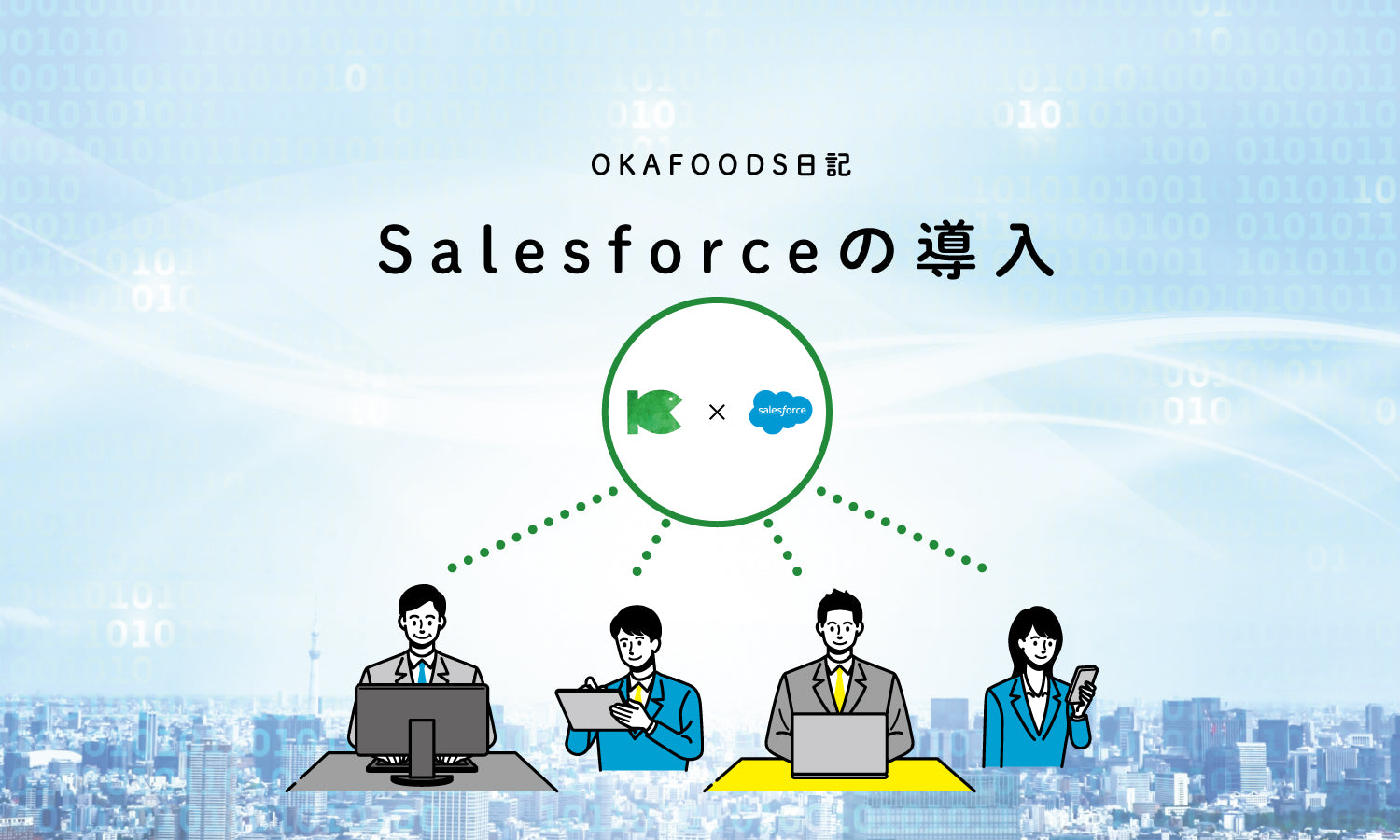1. Introduction of Salesforce
Introducing Salesforce
Before the introduction, Okafoods' sales and marketing activities mainly involved sharing contact history with customers through presentations by sales representatives at sales meetings, and customer information was also managed on an Excel-based basis. This resulted in some issues, such as important information not being transferred when the person in charge changed.
Regarding raw material procurement activities, the company made purchasing decisions by making full use of an original system built with Microsoft Access, but there were concerns that maintenance would not be possible if a system problem occurred, and the company felt that there was an issue with the lack of progress in accumulating, visualizing, analyzing, and utilizing data in both sales and procurement.
Therefore, we started selecting tools, focusing on CRM (sales support tools). After the decision was made to introduce SFA, we expanded the scope of development to maximize the use of the SFA environment based on the following three pillars, taking into account ease of development and the issues we had at the time.
Management contents
To make the most of the environment
sample
Sample Management
quality
Quality Defect Management
material
Raw material management
Contents 01: Sample Management
CONTENTS 01: About sample management
A request for a sample is a great opportunity for a user to express interest in trying Okafoods' products, and there's no reason not to take advantage of it. We listen to why users use Okafoods' products, what improvements would make them want to use them more, and how Okafoods' products are specifically useful. We then collect, visualize, analyze, and utilize the data, and then manage it all. We believe this is an important element in further realizing our management philosophy of "being useful to stakeholders."
CONTENTS 02: Quality defect management
CONTENTS 02: About quality defect management
The same data was also transferred to Excel and shared with suppliers and cooperating factories via email and fax, but this required compiling and analyzing the data in Excel every time. We felt that by accumulating, visualizing, analyzing and utilizing data for quality defect management in the same way as sample management, we could improve both the level of customer response and the level of recurrence prevention activities with cooperating factories.
CONTENTS 03: Raw material management
CONTENTS 03: About raw material management
2. SFA utilization status after implementation
SFA utilization status after introduction
On the other hand, with regard to sample management, we were thorough in interviewing and accumulating information about the samples we received from customers on a daily basis, but there was still room for improvement in terms of whether this information was enough to grasp their true issues and needs. Furthermore, to truly be "useful to stakeholders," we needed to know the voices of many users, and in the future we needed to increase the number of points of contact with such users, but there were limits to our resources. We felt that the challenge was how to use digital technology to increase points of contact with users.
Regarding raw material management, although we were able to see the procurement situation and progress of consumption, we wanted to take it a step further and consistently "visualize" the profit and loss of procured raw materials.
Progress has certainly not come to a halt, but I felt that we were not yet using it to the level we had envisioned. We were accumulating data every day, but I wondered if we were actually using it to do anything useful.
3. "TRAILBLAZER" and the creation of a new environment
"TRAIL BLAZER" and to build a new environment
Before actually starting the project, we first began by getting Salesforce to understand Okafoods' corporate philosophy, policies, culture, actual sales activities, etc. We then explained in detail the current usage situation, the issues they faced, and their "ideas" for how they would like to use the system in the future. President Oka himself met with Salesforce for three hours every week for over a month to prepare for the creation of the new environment.
After that, we were introduced to Thomas, who is currently supporting us in building and utilizing the new environment, and the three companies shared and discussed the vision for the future they want to achieve.
Click here to see our collaboration with Thomas⇒https://www.okafoods.jp/blogs/useful/shinka48
The transition to the new environment was completed in November 2021, approximately six months after the project kicked off.
4. DX policy for the 48th fiscal year: "Make full use of SFA!"
DX policy for the 48th term "Thorough utilization of SFA!"
In the new environment, we have focused particularly on creating a place to collect contact points with users and the specific issues and concerns that users have that we have heard about at those points. We work backwards from our goal of how we want to help them, and plot what data items we should collect.
By accumulating data in the SFA on a daily basis, we are not only able to help users who actually use our products by resolving their problems and concerns, but we also have the potential to help our partner food wholesalers with their sales activities.
We have also introduced Tableau (a BI tool) to enable advanced analysis of the accumulated data.
Furthermore, unlike start-from-scratch systems, SFA is a cloud-based subscription service, meaning that standard functions are updated two to three times a year, giving users the advantage of being able to use the latest services. It is also possible to link with a variety of external systems and tools, so we are proactively incorporating new services and tools, and hope to accelerate the use of digital technology to increase our points of contact with users, including sample management. Stay tuned for more SHINKA-related uses of SFA from Okafoods!















